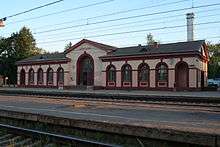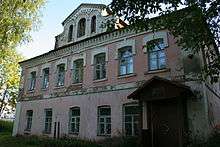Likhoslavlsky District
| Likhoslavlsky District Лихославльский район (Russian) | |
|---|---|
 Location of Likhoslavlsky District in Tver Oblast | |
| Coordinates: 57°07′N 35°28′E / 57.117°N 35.467°ECoordinates: 57°07′N 35°28′E / 57.117°N 35.467°E | |
.svg.png) | |
|
| |
| Location | |
| Country | Russia |
| Federal subject | Tver Oblast[1] |
| Administrative structure (as of 2012) | |
| Administrative center | town of Likhoslavl[1] |
| Administrative divisions: | |
| Urban settlements (towns) | 1 |
| Urban settlements (urban-type settlements) | 1 |
| Rural settlements | 10 |
| Inhabited localities: | |
| Cities/towns | 1 |
| Urban-type settlements[2] | 1 |
| Rural localities | 246 |
| Municipal structure (as of June 2006) | |
| Municipally incorporated as | Likhoslavlsky Municipal District[3] |
| Municipal divisions:[4] | |
| Urban settlements | 2 |
| Rural settlements | 10 |
| Statistics | |
| Area | 1,781 km2 (688 sq mi)[5] |
| Population (2010 Census) | 28,492 inhabitants[6] |
| • Urban | 60.6% |
| • Rural | 39.4% |
| Density | 16/km2 (41/sq mi)[7] |
| Time zone | MSK (UTC+03:00)[8] |
| Official website | |
| Likhoslavlsky District on WikiCommons | |
Likhoslavlsky District (Russian: Лихосла́вльский райо́н) is an administrative[1] and municipal[3] district (raion), one of the thirty-six in Tver Oblast, Russia. It is located in the center of the oblast and borders with Maksatikhinsky District in the north, Rameshkovsky District in the east, Kalininsky District in the south, Torzhoksky District in the southwest, and with Spirovsky District in the northwest. The area of the district is 1,781 square kilometers (688 sq mi).[5] Its administrative center is the town of Likhoslavl.[1] Population: 28,492 (2010 Census);[6] 30,079 (2002 Census);[9] 33,942 (1989 Census).[10] The population of Likhoslavl accounts for 43.0% of the district's total population.[6]
Geography
The area of the district is elongated from south to north. The whole area belongs to the river basin of the Volga River and is split between three of its major tributaries. The rivers in the northern part of the district drain into the Tifina, in the basin of the Mologa River. The central part of the district belongs to the drainage basin of the Medveditsa River. The southern part of the district belongs to the basin of the Tvertsa River. Both the Tifina and the Medveditsa cross the district.
History
In the Middle Ages, the area belonged to the Novgorod Republic. In 1238, the Mongols were advancing from Bezhetsk towards Tver and engaged in a battle with Slavs at the banks of the Medveditsa, currently within the area of the district. Mongols won the battle and got the control of the area. After the Novgorod Republic has been annexed by the Grand Duchy of Moscow in the end of the 15th century, the area was a part of the Bezhetsk pyatina, one of the five pyatinas into which the Novgorod lands were divided. The village of Ostashkovo, which later was merged into the town of Likhoslavl, was first mentioned in 1624.[11]
In the course of the administrative reform carried out in 1708 by Peter the Great, the area was included into Ingermanlandia Governorate (since 1710 known as Saint Petersburg Governorate). In 1727 part of it was transferred to the newly established Novgorod Governorate, and the rest to Moscow Governorate. In 1775, Tver Viceroyalty was formed from the lands which previously belonged to Moscow and Novgorod Governorates, and the whole area was transferred to Tver Viceroyalty, which in 1796 was transformed to Tver Governorate. The area was split between Tverskoy, Bezhetsky, and Novotorzhsky Uyezds. In 1925, Likhoslavl was granted town status.[11]
On July 12, 1929 the governorates and uyezds were abolished. Likhoslavlsky District, with the administrative center in Likhoslavl, was established within Tver Okrug of Moscow Oblast. On July 23, 1930, the okrugs were abolished, and the districts were directly subordinated to the oblast. On January 29, 1935 Kalinin Oblast was established, and Likhoslavlsky District was transferred to Kalinin Oblast. On July 9, 1937 Likhoslavlsky District was included into Karelian National Okrug, which was established as a Tver Karelians autonomy. On February 7, 1939 the okrug was abolished.[12] In February 1963, during the abortive administrative reform by Nikita Khrushchev, Likhoslavlsky District was merged into Torzhoksky District, but on March 4, 1964 it was re-established.[11][12] In 1990, Kalinin Oblast was renamed Tver Oblast.
Another district created on July 12, 1929 was Tolmachyovsky District with the administrative center in the selo of Tolmachi. It was a part of Tver Okrug of Moscow Oblast. On January 29, 1935 the district was transferred to Kalinin Oblast, and on March 5, 1935 it was renamed Novokarelsky District. On July 9, 1937 it was transferred to Karelian National Okrug. On July 4, 1956 the district was abolished and split between Spirovsky and Likhoslavlsky Districts.[12]
Economy
Industry
There are enterprises of electrotechnical, ceramic, and food industries in the district.[13]
Agriculture
The main agricultural specialization of the district is cattle breeding with meat and milk production.[14]
Transportation

The railway connecting Moscow and Saint Petersburg crosses the southwestern part of the district. The biggest stations within the district are Likhoslavl and Kalashnikovo. In Likhoslavl, a railway branches west and leads to Torzhok and further to Ostashkov and Rzhev.
Likhoslavl and Kalashnikovo are connected by road with Torzhok, where they have access to the M10 hghway connecting Moscow and Saint Petersburg. Likhoslavl is also connected by road with Mednoye, where it has another access to M10. There are also local roads with bus traffic originating from Likhoslavl.
Culture and recreation

The district contains seven cultural heritage monuments of federal significance and additionally fifty objects classified as cultural and historical heritage of local significance (seven of them located in Likhoslavl). The federal monuments are the Saint Nicholas Church in the selo of Zmeyevo, the Intercession Church in the selo of Stan, and the Pervitino Estate in the selo of Pervitino.[15]
Likhoslavlsky District is one of four districts of Tver Oblast with a significant number of Tver Karelians.[16] In Likhoslavl, there is a local museum mostly devoted to Tver Karelian culture and ethnography.[17]
References
Notes
- 1 2 3 4 Государственный комитет Российской Федерации по статистике. Комитет Российской Федерации по стандартизации, метрологии и сертификации. №ОК 019-95 1 января 1997 г. «Общероссийский классификатор объектов административно-территориального деления. Код 28 238», в ред. изменения №259/2014 от 12 декабря 2014 г.. (State Statistics Committee of the Russian Federation. Committee of the Russian Federation on Standardization, Metrology, and Certification. #OK 019-95 January 1, 1997 Russian Classification of Objects of Administrative Division . Code 28 238, as amended by the Amendment #259/2014 of December 12, 2014. ).
- ↑ The count of urban-type settlements may include the work settlements, the resort settlements, the suburban (dacha) settlements, as well as urban-type settlements proper.
- 1 2 Law #4-ZO
- ↑ Law #35-ZO
- 1 2 Официальный сайт Администрации Лихославльского района Тверской области (in Russian). Администрация Лихославльского района Тверской области. Retrieved 26 March 2014.
- 1 2 3 Russian Federal State Statistics Service (2011). "Всероссийская перепись населения 2010 года. Том 1" [2010 All-Russian Population Census, vol. 1]. Всероссийская перепись населения 2010 года (2010 All-Russia Population Census) (in Russian). Federal State Statistics Service. Retrieved June 29, 2012.
- ↑ The value of density was calculated automatically by dividing the 2010 Census population by the area specified in the infobox. Please note that this value is only approximate as the area specified in the infobox does not necessarily correspond to the area of the entity proper or is reported for the same year as the population.
- ↑ Правительство Российской Федерации. Федеральный закон №107-ФЗ от 3 июня 2011 г. «Об исчислении времени», в ред. Федерального закона №271-ФЗ от 03 июля 2016 г. «О внесении изменений в Федеральный закон "Об исчислении времени"». Вступил в силу по истечении шестидесяти дней после дня официального опубликования (6 августа 2011 г.). Опубликован: "Российская газета", №120, 6 июня 2011 г. (Government of the Russian Federation. Federal Law #107-FZ of June 31, 2011 On Calculating Time, as amended by the Federal Law #271-FZ of July 03, 2016 On Amending Federal Law "On Calculating Time". Effective as of after sixty days following the day of the official publication.).
- ↑ Russian Federal State Statistics Service (May 21, 2004). "Численность населения России, субъектов Российской Федерации в составе федеральных округов, районов, городских поселений, сельских населённых пунктов – районных центров и сельских населённых пунктов с населением 3 тысячи и более человек" [Population of Russia, Its Federal Districts, Federal Subjects, Districts, Urban Localities, Rural Localities—Administrative Centers, and Rural Localities with Population of Over 3,000] (XLS). Всероссийская перепись населения 2002 года [All-Russia Population Census of 2002] (in Russian). Retrieved August 9, 2014.
- ↑ Demoscope Weekly (1989). "Всесоюзная перепись населения 1989 г. Численность наличного населения союзных и автономных республик, автономных областей и округов, краёв, областей, районов, городских поселений и сёл-райцентров" [All Union Population Census of 1989: Present Population of Union and Autonomous Republics, Autonomous Oblasts and Okrugs, Krais, Oblasts, Districts, Urban Settlements, and Villages Serving as District Administrative Centers]. Всесоюзная перепись населения 1989 года [All-Union Population Census of 1989] (in Russian). Институт демографии Национального исследовательского университета: Высшая школа экономики [Institute of Demography at the National Research University: Higher School of Economics]. Retrieved August 9, 2014.
- 1 2 3 История края (in Russian). Официальный сайт Администрации Лихославльского района Тверской области. Retrieved 28 March 2014.
- 1 2 3 Справка об изменениях в административно-территориальном делении Тверской губернии - Калининской области (in Russian). Архивы России. Retrieved 29 March 2014.
- ↑ Предприятия Лихославльского района (in Russian). Официальный сайт Администрации Лихославльского района Тверской области. Retrieved March 28, 2014.
- ↑ Сельское хозяйство (in Russian). Официальный сайт Администрации Лихославльского района Тверской области. Retrieved March 28, 2014.
- ↑ Памятники истории и культуры народов Российской Федерации (in Russian). Russian Ministry of Culture. Retrieved 2 June 2016.
- ↑ Манаков, А.Г. (2002). Геокультурное пространство северо-запада Русской равнины: Динамика, структура, иерархия (in Russian). Pskov: Центр «Возрождение». ISBN 5-902166-02-0.
- ↑ Карельский национальный краеведческий музей (in Russian). Российская сеть культурного наследия. Retrieved March 28, 2014.
Sources
- Законодательное Собрание Тверской области. Закон №4-ЗО от 18 января 2005 г. «Об установлении границ муниципальных образований Тверской области и наделении их статусом городских округов, муниципальных районов», в ред. Закона №65-ЗО от 24 июля 2012 г. «О внесении изменения в статью 2 Закона Тверской области "Об установлении границ муниципальных образований Тверской области и наделении их статусом городских округов, муниципальных районов"». Вступил в силу через десять дней после официального опубликования. Опубликован: "Тверские ведомости", №3, 21–27 января 2005 г. (Legislative Assembly of Tver Oblast. Law #4-ZO of January 18, 2005 On Establishing the Borders of the Municipal Formations of Tver Oblast and on Granting Them the Status of Urban Okrugs, Municipal Districts, as amended by the Law #65-ZO of July 24, 2012 On Amending Article 2 of the Law of Tver Oblast "On Establishing the Borders of the Municipal Formations of Tver Oblast and on Granting Them the Status of Urban Okrugs, Municipal Districts". Effective as of the day which is ten days after the official publication.).
- Законодательное Собрание Тверской области. Закон №35-ЗО от 28 февраля 2005 г. «Об установлении границ муниципальных образований, входящих в состав территории муниципального образования Тверской области "Лихославльский район", и наделении их статусом городского, сельского поселения», в ред. Закона №52-ЗО от 6 июня 2006 г. «О внесении изменений в отдельные Законы Тверской области, регулирующие вопросы установления границ муниципальных образований Тверской области». Вступил в силу со дня официального опубликования. Опубликован: "Тверские ведомости", №10, 11–17 марта 2005 г. (Legislative Assembly of Tver Oblast. Law #35-ZO of February 28, 2005 On Establishing the Borders of the Municipal Formations Comprised by the Territory of the Municipal Formation of "Likhoslavlsky District" and on Granting Them the Status of Urban, Rural Settlements, as amended by the Law #52-ZO of June 6, 2006 On Amending Various Laws of Tver Oblast on Regulating the Issues of Establishing the Borders of the Municipal Formations of Tver Oblast. Effective as of the day of the official publication.).